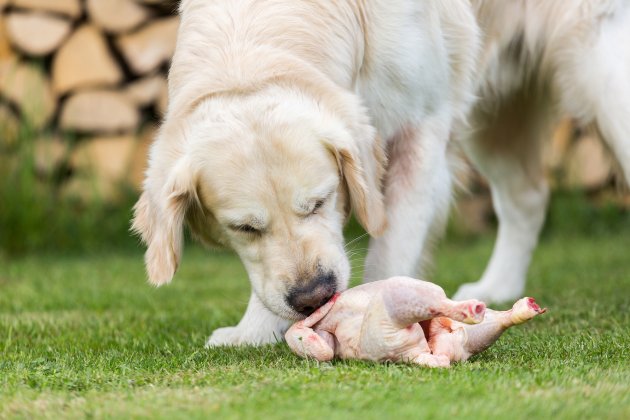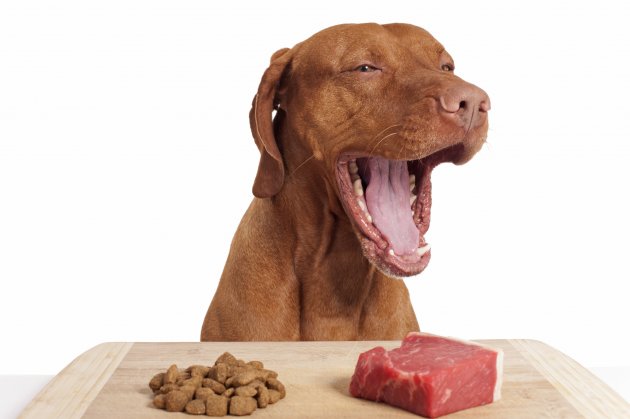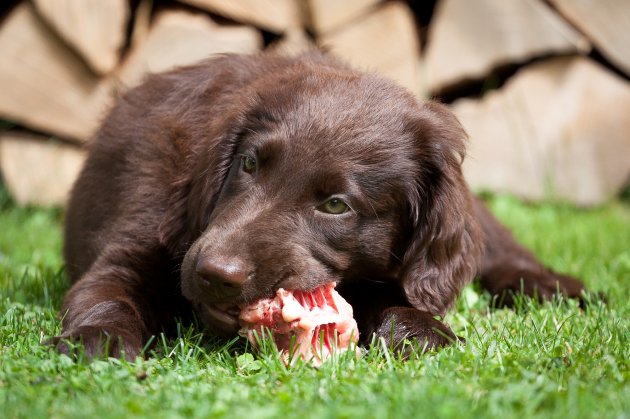Many people have become more aware of what they eat on a daily basis and are now curious as to what their dog's food consists of. This article will give you information on feeding a raw diet to our pets and the pros and cons of feeding them. It will also explain the difference in raw food, homemade diets, and commercial brand diets.
What does a Raw dog food diet consist of?
A raw food diet consists of uncooked meat that is usually still on the bone. They can still be whole or ground up into a powder and used in organ meats such as liver, kidney and hearts, Raw eggs, vegetables, fruit and some dairy such as yogurt.

Benefits of feeding a raw diet
There are some good things that do come from feeding a raw diet to your pet. Feeding a raw diet can provide nutrients that are responsible for creating a healthy shiny coat. Their skin may seem healthier due to more natural ingredients. Dogs are known to have dental disease at least sometime during their lives. Feeding a raw diet can cause your dog’s teeth to be a little bit cleaner because they do not contain all of the unhealthy preservatives found in commercial dog foods which cause excessive tartar build-up. Since the diet is very high in protein your dog may have a higher energy level. This high protein diet will also lead to smaller stools because their bodies will utilize more of the natural fats and fibers thus creating less waste.
Feeding raw diets guarantees that your pet will have some of the healthiest and freshest foods without all the added fillers and preservatives. These preservatives help keep the food from spoiling. Without the preservatives, you will need to make sure that your pet eats all their food as soon as you give it to them, and it not stay sitting out untouched for hours.
The problems caused by feeding a raw diet to your dog
Where there are a few good reasons to feed a raw diet and there are a lot of not so good reasons. Raw meat can contain bacteria. If these bacteria are eaten it can lead to serious problems for both people and animals. This is why when you go to a restaurant that serves raw or undercooked food there is a warning that this food may make you sick. The most common bacteria that veterinarians worry about with feeding raw diets are Salmonella, Listeria and E. coli. All three of these bacteria will cause gastrointestinal signs for you or your dog.
Many of the raw diets contain whole bones though it is best to avoid feeding them. The bones can puncture the stomach or intestines as they try to pass through leading to serious medical problems. If the bowl of a dog is perforated by a bone and gastric content leaks out into the abdomen your pet would need costly emergency surgery. Not only can the bones penetrate the intestines, but they can cause teeth to break while they are chewing as well.

Make sure the raw diet is fresh
When feeding a raw diet you will have to set aside some time to prepare their food. Some people will do this ahead of time and freeze the food into daily potions and only take out a few days at a time to thaw. Some animals are very picky and will not eat raw diets if they are not made fresh daily. This can be very time consuming on you.
Make sure it is completely balanced
With raw diets, it is very hard to feed a diet that is completely balanced and contains all the needed vitamins and minerals for your pet to stay healthy. If a pet eats a diet that is lacking in the essential nutrients for a long period of time, they can have major medical problems due to this deficiency. You should consult a veterinarian before starting a raw diet so they can help you develop a meal plan that provides the appropriate nutrients for your dog. Sometimes it is necessary to supplement their diet with specific vitamins. These vitamins are typically sold at local pet stores and online and are not usually very expensive.
Risks
While the risk seems to outweigh the rewards of raw diets many people are against feeding commercial dog food. The same risk exists among both types of food. There have been recalls recently on commercial dog foods containing salmonella and e.coli. So there is risk either way. It all boils down to what you and your dog like. What they will eat and how convenient is it to prepare. These are questions that should be considered.Alternatives to raw diets
Feeding raw diets
Pros and Cons of Feeding a Raw Diet
Pros
- • All Natural Ingredients
- • You know what you are feeding to your dog
Cons
- • Does not have added preservatives
- • Can Cause health problems if food not properly cared for
- • May not contain the needed vitamins and minerals
- • Can be very expensive
- • Time-consuming
- • Need a large freezer.

Commercial Dog Food Diets
Pros and Cons of feeding a Commercial Diet
Pros
- Easy to Feed
- Well-balanced diet
Cons
- Has added preservatives
- Cannot easily customize for your dog
A commercial brand dog food has been tested to make sure that it is a complete diet for your dog. The food in the diet has preservatives to keep it fresh and eliminate the potential risk for any toxins that could cause your pet harm. When buying foods with more natural preservatives make sure to check the best by date and avoid stocking large quantities of food at a time. Feeding food after the given date can result in potentially severe illness.

Feeding a commercial dog food
If you do decide to feed a commercially prepared dog food look at the ingredients that you are feeding them. Make sure that protein is one of the first ingredients. While there are grain free dog foods, recent studies have shown that they lead to heart disease and some grains are needed in your dog's food. While all commercial dogs foods need to have some kind of preservative to help keep the food fresh. There are some more natural preservatives such as tocopherols (vitamin E), citric acid (vitamin C), and rosemary extract. These preservatives do not keep the food as long as others, so we do not recommend that you buy these foods in bulk.
Transitioning from one Diet to the next
If you are changing from one type of diet to the next start off slow. Slowly change from one diet to the next by adding about ¼ new food and ¾ old food for a few days. After a few days of this mixture, then mix the foods ½ old food and ½ new food. Feed this mixture for a few days. Then go to ¾ new food and 1/4th old food for 3 to 4 days.
Finally, as long as your dog is doing good feed only the new diet. Changing the diet suddenly from one type the next can cause gastric upset and diarrhea. If you notice diarrhea in your dog after switching food. Even if switching between two different kinds of the same diet can cause an upset stomach in a dog with a sensitive stomach. If diarrhea lasts for more than a few days, seek veterinary attention for your pet as there may be a major problem going on with your dog.
What is an example of a Raw Food Diet
It is best to ask your veterinarian for help with figuring out what is best to feed our dog. The type of diet they recommend will depend on what type of dog you have, how old it is and any underlying medication condition that they may have. Your veterinarian can help you figure out a good raw food diet to feed your pet. This is just an example of a raw food diet that a dog can eat.
Ingredients Needed:
- 2 1/2 lbs ground beef
- 4 oz chicken livers
- 1 carrot chopped
- 1 small apple with the seeds removed
- 1/2 c baby spinach
- 2 whole eggs including the shell
- 1/2 c plain yogurt
- 1 tbsp ground flaxseed
- 1 tbsp olive oil
Put all the vegetables into a food processor and chop them up very fine. Mix all of these ingredients up, and divide them out into daily portions. Freeze all packages of food and only unfreeze 1 to 2 days’ worth of food at a time. If you unfreeze more food than this, it can spoil before your dog can eat the food.
A good rule of thumb when trying to figure out how much food to feed your pet is about 1 cup for 15 pounds of body weight. When you feed your pet make sure that they eat all their food at one time. If they do not eat all their food, throw away any uneaten food as this can quickly grow bacteria that can lead to a very serious medical condition.
Conclusion
There are many different options when it comes to feeding your pet. Make sure that the way that you chose works with your lifestyle. If you are always busy and on the go then feeding a fresh everyday raw diet may not be the easiest way to go. If you still want to feed a raw diet, then looking at the premade dog food options may be the way to go. While the dog food choices are limitless, you must figure out exactly what works for you and your pet so you can both be happy and healthy for years to come.
Resources and further reading:
- AVMA, Raw Pet Foods and the AVMA's Policy: FAQ
- AVMA, Raw or Undercooked Animal-Source Protein in Cat and Dog Diets
- NCBI, Daniel P. Schlesinger and Daniel J. Joffe, Raw food diets in companion animals: A critical review